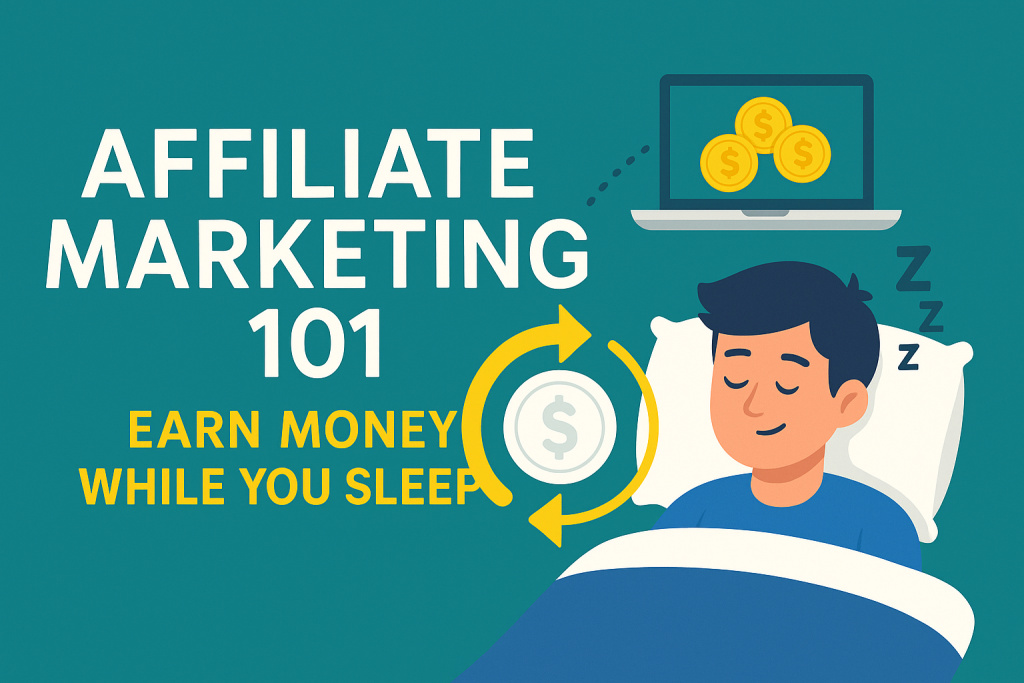What Is Affiliate Marketing and How Does It Work?
Have you ever clicked on a YouTube link or blog post recommending a product—only to later find out it was an affiliate link? That’s affiliate marketing in action. But what exactly is it, and why is it such a powerful tool for both beginners and professionals trying to earn money online?
Affiliate marketing is one of the most accessible and scalable ways to generate passive income. And the best part? You don’t need your own product or service to start. In this post, we’ll break down what affiliate marketing is, how it works step-by-step, and how you can start making money from it—even with zero experience.
What Is Affiliate Marketing?
Affiliate marketing is a performance-based marketing strategy where individuals (affiliates) promote products or services created by others and earn a commission for each sale or action made through their unique referral link.
According to Statista, affiliate marketing spending in the U.S. alone is expected to hit $13 billion by 2025, reflecting how powerful and profitable the model has become.
How Does Affiliate Marketing Work?
Here’s a simplified look at how the affiliate marketing process works:
-
Join an Affiliate Program: You sign up with a company or affiliate network.
-
Get a Unique Affiliate Link: This link tracks clicks and sales made through you.
-
Promote the Product: Share the link via blog, YouTube, social media, or email.
-
Earn Commissions: When someone clicks your link and makes a purchase, you earn a cut.
Let’s visualize this in a quick comparison table:
| Role | Responsibility | Example |
|---|---|---|
| Merchant | Creates the product or service | Amazon, Bluehost, Nike |
| Affiliate (You) | Promotes product via custom links | Blogger, influencer, YouTuber |
| Customer | Clicks affiliate link and makes a purchase | Follower from your content |
| Network | Manages the affiliate tracking and payouts | ShareASale, CJ, ClickBank |
Types of Affiliate Marketing
Affiliate marketing isn’t one-size-fits-all. Here are the three primary models:
1. Unattached Affiliate Marketing
You promote products without a personal connection. Think of Google Ads or Facebook Ads with affiliate links.
-
Pros: Scalable, fast to launch
-
Cons: Lower trust and conversion
2. Related Affiliate Marketing
You promote products related to your niche, but haven’t used them personally.
-
Pros: Easy to integrate into content
-
Cons: Medium trust level
3. Involved Affiliate Marketing
You actively use the product and endorse it based on personal experience.
-
Pros: High trust, better conversion
-
Cons: Requires time and credibility
How to Get Started with Affiliate Marketing
Starting affiliate marketing doesn’t require a lot of money, but it does need strategy and patience.
Step 1: Pick a Niche
Focus on a niche that is profitable and that you care about. Examples:
-
Health & Fitness
-
Personal Finance
-
Tech & Gadgets
-
Digital Marketing
Step 2: Choose the Right Affiliate Programs
Some top platforms include:
-
Amazon Associates – great for general products
-
ClickBank – ideal for digital products
-
ShareASale – offers a wide range of merchants
-
CJ Affiliate – excellent for premium brand partnerships
Step 3: Build a Platform
Choose where you’ll promote your links:
-
A blog (WordPress or Medium)
-
YouTube channel
-
Instagram or TikTok account
-
Email newsletter
Step 4: Create Quality Content
Offer value first. Don’t just post links—build trust. Great affiliate content types include:
-
Honest product reviews
-
Tutorials and how-to guides
-
“Best of” lists (e.g., Best Laptops for Students)
-
Comparison posts (e.g., Bluehost vs Hostinger)
Step 5: Drive Traffic
No traffic = no commissions. Focus on:
-
SEO (Search Engine Optimization)
-
Pinterest for visual niches
-
Social media marketing
-
Email list building
Real-World Results: A Case Study
One of the most famous affiliate marketers is Pat Flynn of Smart Passive Income. He began with a simple blog and has since earned over $3 million in affiliate commissions. His success wasn’t due to hacks, but through:
-
Building trust with his audience
-
Recommending tools he genuinely used
-
Creating valuable content first
Even smaller creators can make $100–$2,000/month with consistent effort.
✅ Benefits of Affiliate Marketing
| Benefit | Explanation |
|---|---|
| Low Start-Up Cost | No need to create a product or handle inventory |
| Passive Income Potential | Earn money while you sleep from evergreen content |
| Scalability | Promote multiple products or scale through paid ads |
| Flexibility | Work from anywhere and choose your niche & products |
⚠️ Common Mistakes to Avoid
-
Promoting too many unrelated products
→ Stick to your niche for trust and clarity. -
Not disclosing affiliate links
→ It’s legally required and builds credibility. -
Focusing only on high commission rates
→ Promote what fits your audience best, not just what pays more.
Internal & External Linking Suggestions
-
Internal: Read our post on How to Choose a Niche for Affiliate Marketing
-
External: Learn about affiliate laws from the FTC Guidelines
Visual Summary: The Affiliate Marketing Flywheel
Infographic (idea):
-
Choose a Niche
-
Join a Program
-
Create Content
-
Drive Traffic
-
Earn Commissions
-
Reinvest & Scale
Final Thoughts: Is Affiliate Marketing Right for You?
Affiliate marketing is not a get-rich-quick scheme. But it is one of the most powerful paths to building long-term online income when done with care and consistency. If you can build trust, provide value, and stay committed, affiliate marketing can absolutely work for you.
Call to Action
Are you ready to start your affiliate journey?
Download our free Affiliate Marketing Starter Kit or explore our recommended affiliate tools.
And don’t forget to subscribe to our newsletter for weekly strategies on growing your online income!



